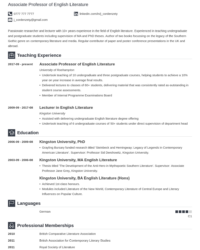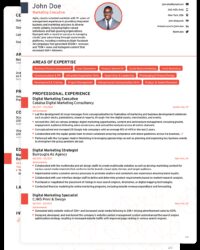Utilizing such a framework offers several advantages. It helps applicants organize their information strategically, highlighting the most pertinent details for graduate study. This targeted approach increases the likelihood of making a positive impression on admissions committees. Additionally, it can save applicants valuable time and effort by providing a clear roadmap for presenting their qualifications. A well-designed framework ensures consistency and professionalism, potentially enhancing an application’s overall impact.
This discussion will further explore the key elements of a well-structured curriculum vitae for graduate program applications, providing practical guidance for crafting a compelling and competitive document. Specific topics include content organization, formatting best practices, and strategies for tailoring the document to different program requirements.
Key Components of a Curriculum Vitae for Master’s Program Applications
A compelling curriculum vitae for master’s program applications requires careful consideration of key components to showcase an applicant’s qualifications effectively. The following elements contribute significantly to a strong and competitive application.
1. Contact Information: Accurate and up-to-date contact details are essential, including full name, phone number, email address, and professional website or LinkedIn profile (if applicable). A clear and professional presentation of this information ensures ease of communication.
2. Educational Background: This section should list academic degrees in reverse chronological order, starting with the most recent. Include institution names, degree titles, majors, graduation dates, and relevant coursework, particularly if it aligns with the target program.
3. Research Experience: Detail any research projects undertaken, highlighting roles, responsibilities, methodologies, and outcomes. Quantifiable results and publications should be emphasized to demonstrate research capabilities.
4. Professional Experience: Relevant work experience, including internships, volunteer roles, and part-time positions, should be listed with clear descriptions of responsibilities and accomplishments. Focus on transferable skills and experiences applicable to the desired program.
5. Skills: Technical skills, software proficiency, language fluency, and other relevant abilities should be presented concisely. Provide specific examples and proficiency levels where appropriate to demonstrate competency.
6. Awards and Honors: List any academic, professional, or extracurricular achievements, including scholarships, grants, fellowships, and Dean’s List recognitions. This section showcases accomplishments and dedication.
7. Publications and Presentations: Include any published works, conference presentations, or other scholarly contributions. Provide complete citations and links where possible to demonstrate research impact.
8. References: While not always included directly in the CV, it’s crucial to have a separate list of professional references ready to provide upon request. Inform references beforehand and ensure their contact information is current.
Strategic inclusion and presentation of these components create a comprehensive and compelling narrative of an applicant’s qualifications, enhancing their candidacy for the target master’s program. Careful attention to detail and tailoring to specific program requirements are essential for maximizing impact.
How to Create a Curriculum Vitae for Master’s Applications
Developing a strong curriculum vitae is crucial for successful master’s program applications. A well-crafted CV effectively communicates qualifications and experiences to admissions committees. The following steps provide guidance for creating a compelling document.
1. Select a Template: Choose a professional and clean template, ensuring readability and visual appeal. A consistent format enhances clarity and professionalism.
2. Tailor Content: Carefully review program requirements and tailor the CV to highlight relevant skills and experiences. Emphasize qualifications aligned with the specific program’s focus.
3. Structure Information Strategically: Organize information logically using clear headings and subheadings. Prioritize content based on relevance to the target program.
4. Quantify Achievements: Use metrics and quantifiable results to demonstrate impact. For example, instead of stating “Improved sales,” quantify the improvement with specific percentages or figures.
5. Proofread Carefully: Thorough proofreading is essential to eliminate errors in grammar, spelling, and punctuation. A polished document demonstrates professionalism and attention to detail.
6. Seek Feedback: Request feedback from mentors, professors, or career advisors to identify areas for improvement. An external perspective can provide valuable insights.
Creating a compelling curriculum vitae requires strategic planning, thoughtful content curation, and meticulous attention to detail. A well-structured and tailored CV enhances an application’s impact, showcasing qualifications effectively to admissions committees and increasing the likelihood of acceptance into the desired program.
A well-structured framework for a curriculum vitae tailored to master’s program applications provides a crucial foundation for presenting qualifications effectively. Strategic organization, content prioritization, and careful tailoring to specific program requirements maximize impact on admissions committees. A compelling curriculum vitae highlights relevant academic credentials, research experience, professional skills, and accomplishments, showcasing an applicant’s suitability for graduate study.
Developing a strong curriculum vitae represents a significant investment in one’s academic and professional future. Careful attention to detail, thorough self-assessment, and continuous refinement of this essential document enhance an applicant’s competitiveness and potential for success in securing admission to desired master’s programs. A compelling curriculum vitae serves as a cornerstone of a successful application, paving the way for advanced study and career advancement.


